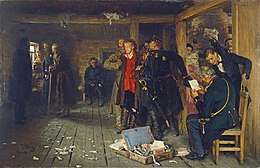Going to the People
Going to the People (Russian: Хождение в народ) was a populist movement in the Russian Empire.

It was largely inspired by the work of Russian theorists such as Mikhail Bakunin and Pyotr Lavrov, who advocated that groups of dedicated revolutionaries could inspire a mass movement to overthrow the ruling class, especially as it concerned the peasantry.[1] In 1874, approximately 2,000 to 4,000 students traveled to rural parts of the empire in order to live among the serfs and "prepare them for their future political role."[2][3]:202[4]
Many of these youths had never before visited the villages of Russia, but sought to adopt their manner of dress and take up jobs as manual laborers as a way of engaging the population.[5][4] They found the people often unperceptive to their revolutionary message, with many turning over their "exotic urban visitors" to government authorities.[5][6]
It was ultimately a failure, and by the Autumn of that year more than a thousand arrests were made. They failed to inspire "unrest even on a local scale" or to establish local footholds for future activities.[4][7]
Of those arrested, many spent three to four years imprisoned, until a group was eventually brought to court in the 1877 Trial of the 193. In the end, 90 were acquitted and 28 were sentenced to hard labor.[3]:54[8]
References
- Victor Terras (1985). Handbook of Russian Literature. Yale University Press. pp. 351–. ISBN 978-0-300-04868-1.
- Leonard Schapiro (1982). Turgenev, His Life and Times. Harvard University Press. pp. 259–. ISBN 978-0-674-91297-7.
- Jonathan Bromley (2002). Russia 1848-1917. Heinemann. pp. 202–. ISBN 978-0-435-32718-7.
- Daniel P. Todes (15 October 2014). Ivan Pavlov: A Russian Life in Science. Oxford University Press. pp. 95–. ISBN 978-0-19-939444-9.
- Isaiah Berlin (7 March 2013). Russian Thinkers. Penguin Books Limited. pp. 281–. ISBN 978-0-14-139317-9.
- Orlando Figes (11 February 2014). Natasha's Dance: A Cultural History of Russia. Henry Holt and Company. pp. 304–. ISBN 978-1-4668-6289-0.
- Ben Eklof; Tatiana Saburova (6 October 2017). A Generation of Revolutionaries: Nikolai Charushin and Russian Populism from the Great Reforms to Perestroika. Indiana University Press. pp. 111–. ISBN 978-0-253-03125-9.
- A. T. Lane (1995). Biographical Dictionary of European Labor Leaders. Greenwood Publishing Group. pp. 1057–. ISBN 978-0-313-29900-1.
External links
